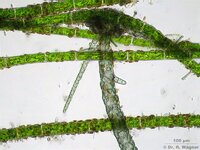G
Guest
Guest
Potassium deficiency allows staghorn to colonize leaves. K deficiency also causes necrosis.
Potassium deficiency allows staghorn to colonize leaves. K deficiency also causes necrosis.



In the What Exactly Causes BBA? thread, ourmanflint added a blue light filter and reported that the rate of algae growth reduced. When he removed the filter, it speeded up again.
In my Google searches, I found reference to the proteins in red algae and Cyanobacteria, responsible for capturing light - phycobillisome (https://en.m.wikipedia.org/wiki/Phycobilisome).
Also, Biocon labs made reference to autotrophic bacteria being more sensitive to blue/uv light.
So in addition to adding vitamin B12, relieve yourself into the aquarium to supply the urea. Who's willing to do this experiment?
I've been dosing urea with great results, some plants really liked it. The downside is that if dosed too much, BBA started to appear. And that was a planted tank where growth, maintinance, dosing, CO2,... was excellent.
Never dosed vit. B12 though.
I think there could be "legs" in this, but it is going to be very difficult to prove.I'm proposing here that BBA requires a higher concentration of urea/ammonia as its nitrogen source, with other compounds such as vitamin B12 to create the compounds it needs to reproduce.
We don't know exactly which specie(s) of Rhodophyta we have in the aquarium.

Darrel,Most symbiotic, or mutualistic bacteria, are specialists rather than opportunists.
